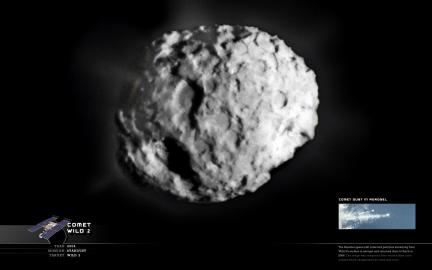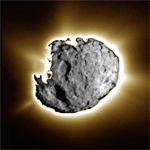 When the Stardust spacecraft passed nearby the comet Wild 2, it opened up a container that held a material called aerogel exposing it to high velocity particle impacts originating from the surface of Wild 2. You can see the haze and jet streams of these particles flowing from various points on Wild 2 and creating what is known as the coma around the comet nucleus. Once the encounter was completed, the Stardust spacecraft returned the samples captured to Earth, in 2006, and successfully completed one of the very few robotic sample return missions ever attempted.
When the Stardust spacecraft passed nearby the comet Wild 2, it opened up a container that held a material called aerogel exposing it to high velocity particle impacts originating from the surface of Wild 2. You can see the haze and jet streams of these particles flowing from various points on Wild 2 and creating what is known as the coma around the comet nucleus. Once the encounter was completed, the Stardust spacecraft returned the samples captured to Earth, in 2006, and successfully completed one of the very few robotic sample return missions ever attempted.
WALLPAPER NOTE: The wallpaper image itself has been greatly reverse manipulated. The most common image from this mission to be found in any publication, or by doing a Google search, is the one seen at left. This image is obviously enhanced and most notably in the edges on the upper left, look absolutely fake. However, what looks like glowing light around this image is based upon data actually captured by the Stardust cameras of dust and gas flowing from Wild 2’s surface. So it was possible to go back to the original nucleus image, re-mask it and then re-apply the jet streams and coma information in a more realistic way… which is what I did. An image is also provided in the wallpaper of what a small segment of the aerogel and a small cometary dust particle looks like. This aerogel is the lightest solid ever created and its invention is what made the Stardust mission even possible. The blast markings are, for the most part, only impact marks left in the aerogel. Look carefully and you will see tiny white particles at the far end of these blast marks which are pieces of comet Wild 2 itself returned to us here on Earth. Probably the most pristine bits of material ever obtained by mankind from what is considered to be left overs from the earliest days of the formation of the solar system.
The wallpaper image itself has been greatly reverse manipulated. The most common image from this mission to be found in any publication, or by doing a Google search, is the one seen at left. This image is obviously enhanced and most notably in the edges on the upper left, look absolutely fake. However, what looks like glowing light around this image is based upon data actually captured by the Stardust cameras of dust and gas flowing from Wild 2’s surface. So it was possible to go back to the original nucleus image, re-mask it and then re-apply the jet streams and coma information in a more realistic way… which is what I did. An image is also provided in the wallpaper of what a small segment of the aerogel and a small cometary dust particle looks like. This aerogel is the lightest solid ever created and its invention is what made the Stardust mission even possible. The blast markings are, for the most part, only impact marks left in the aerogel. Look carefully and you will see tiny white particles at the far end of these blast marks which are pieces of comet Wild 2 itself returned to us here on Earth. Probably the most pristine bits of material ever obtained by mankind from what is considered to be left overs from the earliest days of the formation of the solar system.